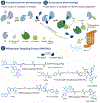PROteolysis TArgeting Chimeras (PROTACs) - Past, present and future
- PMID: 31200855
- PMCID: PMC6578591
- DOI: 10.1016/j.ddtec.2019.01.002
PROteolysis TArgeting Chimeras (PROTACs) - Past, present and future
Abstract
The majority of currently used therapeutics are small molecule-based and utilize occupancy-driven pharmacology as the mode of action (MOA), in which the protein function is modulated via temporary inhibition. New modalities that operate using alternative MOAs are essential for tapping into the "undruggable" proteome. The PROteolysis Targeting Chimera (PROTAC) technology provides an attractive new approach that utilizes an event-driven MOA. Small molecule-based heterobifunctional PROTACs modulate protein target levels by hijacking the ubiquitin-proteasome system to induce degradation of the target. Here, we address important milestones in the development of the PROTAC technology, as well as emphasize key findings from this previous year and highlight future directions of this promising drug discovery modality.
Copyright © 2019 Elsevier Ltd. All rights reserved.
Conflict of interest statement
Conflict of Interest
C.M.C. is founder, shareholder and consultant to Arvinas, Inc. In addition, his lab receives sponsored research support from Arvinas.
Figures




References
-
- Eric V et al. (2017) New Modalities for Challenging Targets in Drug Discovery. Angew. Chem., Int. Ed. 56, 10294–10323 - PubMed
-
- Hopkins AL and Groom CR (2002) The druggable genome. Nat. Rev. Drug Discov. 1, 727–730 - PubMed
-
- Valeur E and Jimonet P (2018) New Modalities, Technologies, and Partnerships in Probe and Lead Generation: Enabling a Mode-of-Action Centric Paradigm. J. Med. Chem 61, 9004–9029 - PubMed
-
- Fuller JC et al. (2009) Predicting druggable binding sites at the protein–protein interface. Drug Discov. Today 14, 155–161 - PubMed
-
- Adjei AA (2006) What Is the Right Dose? The Elusive Optimal Biologic Dose in Phase I Clinical Trials. J. Clin. Oncol 24, 4054–4055 - PubMed
Publication types
MeSH terms
Substances
Grants and funding
LinkOut - more resources
Full Text Sources
Other Literature Sources
Miscellaneous

